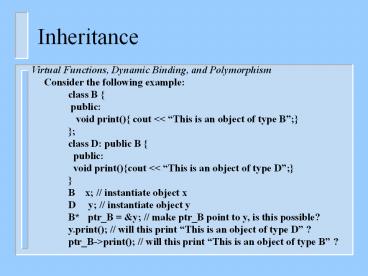Inheritance - PowerPoint PPT Presentation
Title:
Inheritance
Description:
Inheritance Virtual Functions, Dynamic Binding, and Polymorphism Consider the following example: class B {public: void print(){ cout – PowerPoint PPT presentation
Number of Views:62
Avg rating:3.0/5.0
Title: Inheritance
1
Inheritance
- Virtual Functions, Dynamic Binding, and
Polymorphism - Consider the following example
- class B
- public
- void print() cout ltlt This is an object of
type B - class D public B
- public
- void print()cout ltlt This is an object of
type D - B x // instantiate object x
- D y // instantiate object y
- B ptr_B y // make ptr_B point to y, is
this possible? - y.print() // will this print This is an object
of type D ? - ptr_B-gtprint() // will this print This is an
object of type B ? - Can be used to develop a hierarchy of classes
based on abstractions in a top
2
Inheritance
- Virtual Functions , Dynamic Binding, and
Polymorphism (cont.) - A virtual function is a special member function
invoked through a public base class reference or
pointer, it is bound dynamically at run-time, - class B
- public
- virtual void print() cout ltlt This is an object
of type B - class D public B // is exactly the same as in
the previous slide - B x // instantiate object x
- D y // instantiate object y
- B ptr_B y // make ptr_B point to y
- y.print() // will print This is an object of
type D - ptr_B-gtprint() // will also print This is an
object of type D - // The invocation of print() is bound to the
object type not the pointer type
3
Inheritance
- Virtual Functions , Dynamic Binding, and
Polymorphism (cont.) - Dynamic binding is introduced using virtual
functions - The keyword virtual is a function specifier for
member functions of a base class - When a function at the base class class is
declared virtual, all its redefined versions in
the derived classes are bound dynamically
according to the object type for which the
function is invoked, not the pointer or reference
type - Polymorphism is a language mechanism that
permits the same code expression to invoke
different functions depending upon the type of
object using the code, see the example in the
next slide
4
Inheritance
Polymorphism (cont.) Example Consider the
following example, suppose we have several
classes derived from class B above class D1
public B public void print() class D2
public B public void print() . Class Dn-1
public B public void print() Also lets
assume the existence of an array of pointers to
objects as follows, B objects_ptr100 // an
array of pointers to objects of type B or //
objects of type derived from B object_ptr0
new D, object_ptr1 new D1 object_ptr2
new D2 for(int j 0 j lt n
j) object_ptrj-gtprint() // different
print() functions will be invoked // although
we are iterating over the same code expression.
5
Inheritance
- Abstract Classes and Pure Virtual Functions
- An abstract class is a class for which no
objects are created, it is only used as a base
class in order to use virtual functions and
dynamic binding for the objects of its derived
classes, e.g. - class Shape // no objects of type Shape will be
instantiated - class rectangle public Shape // this is a
concrete class.. - class Triangle public Shape // this is another
concrete class. - Shape ptr new rectangle ptr new
Triangle - An abstract class must have at least one pure
virtual function declared as follows, - class Shape public
- virtual void rotate() 0 // the equal 0 means
the function // is a pure virtual function and
it has no body code - The function rotate() only specifies a typical
operation for the types of objects derived from
Shape
6
Inheritance
- Abstract Classes and Pure Virtual Functions
(cont.) - An abstract class can not be used as an argument
type or as a function return type, Shape a //
error, you can not instantiate objects of type
Shape - void fun(Shape x) // error
- void fun(Shape x)// OK
- Shape fun1(void) // error
- Shape fun1(void) // OK
- A reference or a pointer to Shape is of course
allowed since they can be used to refer to an
object of a class derived from Shape - A derived class from an abstract base class also
becomes abstract if the class does not redefine
all the pure virtual functions defined at its
base classes class X virtual void g() 0
virtual void f() 0 - class Y public X void g()// body code
of g// g is redefined - // if f() is not redefined with code, class Y
becomes also an abstract class






























